#DNA clustering
Explore tagged Tumblr posts
Text
Can a 6 cM connection be meaningful?
When it comes to small DNA segments, we’ve heard the “glass half empty” version of the story many times. Here’s the other side of that story.
Submitted for your consideration: A pair of third cousins twice removed and their 6 cM connection…
According to AncestryDNA, Bryan Smith and his cousin, K, share 6 cM of DNA across 1 segment. And according to Ancestry’s ThruLines, Bryan and Cousin K share a pair of third great grandparents, Reuben Willis Smith and his wife Mary Connell.

The cM value is certainly consistent with the identified relationship but did Bryan and Cousin K inherit their shared DNA from the Smith ancestry as shown? Is the 6 cM segment even valid or could it be an artifact of an imperfect DNA matching algorithm?
Let’s start with an easy evaluation: the shared match list.
Among Bryan and K’s list of shared matches at AncestryDNA:
HG, a descendant of Reuben and Mary’s son, Charles Thomas Smith (HG shares 57 cM with Bryan)
RR, a descendant of Reuben and Mary’s daughter, Fannie Janes Smith (RR shares 47 cM with Bryan and 38 cM with K)
IG, another descendant of Reuben and Mary’s son, Charles Thomas Smith (IG shares 47 cM with Bryan and 71 cM with K)
And at least three other descendants of Reuben and Mary are on the shared match list.
So we’re off to a promising start. In addition to the fact that Bryan and K share DNA and a paper trail leading to Ruben and Mary, this group of matches gives us more evidence suggesting that Bryan and K might be related as suspected.
But what about that 6 cM segment shared by Bryan and K? Is it valid? Did it come from the shared Smith ancestors or did it originate elsewhere?
To get the most comprehensive help in answering these questions, we turn to GEDmatch. As indicated in the ThruLine image above, both Bryan and his father are related to DNA Cousin K through their Smith line. And because K is on GEDmatch, we can see that Bryan and his father both share DNA with K on a specific portion of Chromosome 12:

Further investigation reveals that two other descendants of Reuben and Mary, Cousins I and G, share DNA with Bryan and his father on Chromosome 12 in roughly the same location. In fact, all of the matches in question match each other on Chromosome 12:
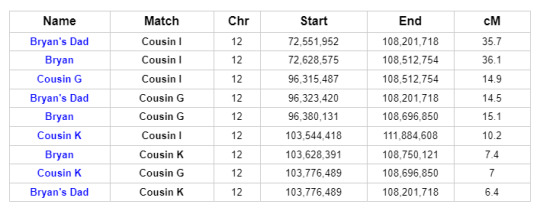
This is what we call a Triangulation Group. It brings the possible genetic connections into sharper focus.
The common segment shared by all of the members of this Triangulation Group indicates that they all share a common ancestor. And we’ve already identified shared ancestry through the Smith line. Cousins I and G are first cousins once removed and they are descendants of Reuben and Mary’s son Charles Thomas Smith...
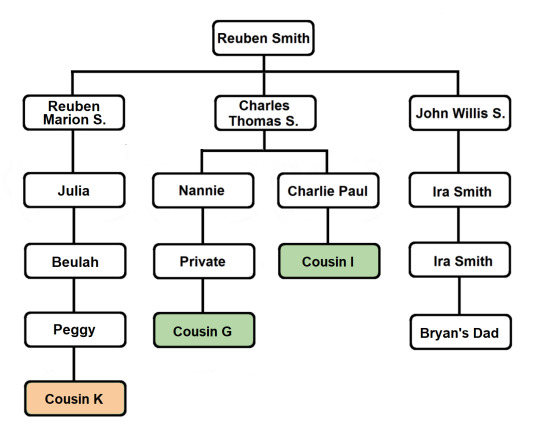
A review of the pedigrees of the matches in question reveals no lines of shared ancestry other than the known shared Smith line. This investigation is summarized briefly in the table below, listing 2nd great grandparent surnames and shared ancestors (blue for paternal names and surnames, light red for maternal names and surnames):
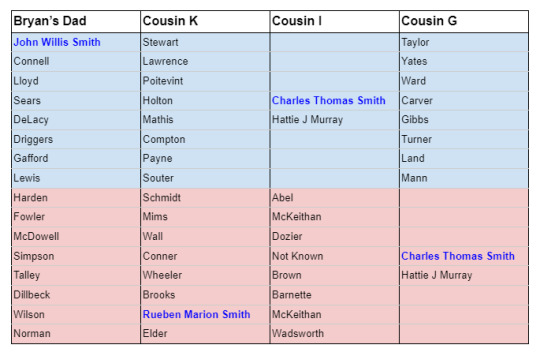
Although we cannot say with perfect certainty that there is no additional common ancestry that conceivably could account for the shared segment of DNA on Chromosome 12, the known evidence doesn’t leave room for much doubt.
For completeness, here’s a chart summarizing the amount of DNA shared by the relatives in question:

And cluster analysis for Cousin G yields a cluster with eight descendants of Reuben Willis Smith, including Bryan Smith and Cousin K:

Not everyone will feel the need to go this far to investigate a 6 cM connection. But this post provides examples of ways to investigate the validity of an ordinary small segment and to determine whether the shared DNA legitimately belongs with the presumed paper trail source of the DNA.
Discussion
Skepticism regarding small segments of shared DNA is appropriate. In comparison to larger shared segments, such segments are more likely to be IBS (false). Additionally, even when small segments can be shown to be reliable, we have to grapple with the fact that small segments can be too old to fall within the reach of reliable historical documentation.
With the exponential growth of the DNA matching databases, the impetus to explore distant matches waned. Reluctance to do the strenuous work involved in using small segments grew. With access to strong genetic connections leading back to target ancestors, why bother with low cM connections?
The sentiment is understandable!
On the other hand, I believe that excessive skepticism has impeded progress in genetic genealogy. As databases have grown, our opportunities for research have multiplied and our research techniques have improved. But at the same time, goalposts for small segment success have been moved to poorly-defined and very unreasonable points.
[From the skeptics: Your success with a small segment doesn’t count if you find a larger segment in a relative! I don’t want to hear about triangulation! Visual phasing is not allowed!]
If we applied such arbitrary restrictions to all areas of genealogy, we’d struggle to get our work done!
Even with our luxuriously large DNA databases, distant genetic connections are the only connections available in some areas of investigation (or to people who hail from less heavily-tested populations). Defeatist refusal to accept low cM matches as evidence in genetic genealogy needlessly limits our potential.
Don’t get me wrong, I’m fully in favor of scholarly rigor. But let’s not allow skepticism to pave the way for denialism!
When distant genetic connections are found to be of dubious quality, they should be set aside. But shared segments should not be judged on the basis of size alone. Even the most fervent opponents of small-segment research will admit that small segments are often valid (IBD). And while these opponents frequently cite IBD/IBS percentages, they ironically fail to see that our ability to find these percentages points directly to a practical method for sorting distant matches on an individual basis.
We are privileged to have access to enormous databases of incredibly valuable genetic information. More than a statistical hiccup that can lead us serendipitously to more reliable information, small DNA segments are messages we carry with us every day, testifying to our connections with our ancestors. Genetic information, even in small amounts, can be just as valuable as any other form of information. We should be good stewards of that information and we should invest good faith effort in understanding how our distant matches can inform us about our rich ancestral history.
I’ll close with this analogy for small segments:
You want some refreshing water but the glass is only half-full. Drink it or toss it out?

Posted with Bryan Smith’s permission. 17 May 2023
#genetic genealogy#DNA testing#DNA#small segments#visual phasing#Triangulation#dna segment#DNA segment triangulation#DNA clustering#clustering#pedigree#family tree#ThruLines
3 notes
·
View notes
Text
‘Teenage Galaxies’ Are Unusually Hot, Glowing With Unexpected Elements - Technology Org
New Post has been published on https://thedigitalinsider.com/teenage-galaxies-are-unusually-hot-glowing-with-unexpected-elements-technology-org/
‘Teenage Galaxies’ Are Unusually Hot, Glowing With Unexpected Elements - Technology Org
Like human teenagers, teenage galaxies are awkward, experience growth spurts and enjoy heavy metal — nickel.
A Webb telescope image of a galaxy cluster known as “El Gordo,” which is an example of a “cosmic teenager.” Image credit: NASA, ESA, CSA
A Northwestern University-led team of astrophysicists has just analyzed the first results from the CECILIA (Chemical Evolution Constrained using Ionized Lines in Interstellar Aurorae) Survey. This program uses NASA’s James Webb Space Telescope (JWST) to study the chemistry of distant galaxies.
According to the early results, so-called “teenage galaxies” — which formed two-to-three billion years after the Big Bang — are unusually hot and contain unexpected elements, like nickel, which are notoriously difficult to observe.
The research was published today (Nov. 20) in The Astrophysical Journal Letters. It marks the first in a series of forthcoming studies from the CECILIA Survey.
“We’re trying to understand how galaxies grew and changed over the 14 billion years of cosmic history,” said Northwestern’s Allison Strom, who led the study. “Using the JWST, our program targets teenage galaxies when they were going through a messy time of growth spurts and change. Teenagers often have experiences that determine their trajectories into adulthood. For galaxies, it’s the same.”
One of the principal investigators of the CECILIA Survey, Strom is an assistant professor of physics and astronomy at Northwestern’s Weinberg College of Arts and Sciences and a member of Northwestern’s Center for Interdisciplinary Exploration and Research in Astrophysics (CIERA). Gwen Rudie, a staff scientist at Carnegie Observatories, co-leads the CECILIA Survey with Strom.
‘Chemical DNA’ gives insight into galaxy formation
Named after Cecilia Payne-Gaposchkin, one of the first women to earn a Ph.D. in astronomy, the CECILIA Survey observes spectra (or the amount of light across different wavelengths) from distant galaxies.
“Naming our JWST survey after Cecilia Payne-Gaposchkin was intended to pay homage to her pioneering studies of the chemical makeup of stars,” Rudie said. “Allison and I recognize that our own work revealing the chemistry of these very early galaxies is built upon her legacy.”
Strom likens a galaxy’s spectra to its “chemical DNA.” By examining this DNA during a galaxy’s “teenage” years, researchers can better understand how it grew and how it will evolve into a more mature galaxy.
For example, astrophysicists still don’t understand why some galaxies appear “red and dead” while others, like our Milky Way, are still forming stars. A galaxy’s spectrum can reveal its key elements, such as oxygen and sulfur, which provide a window into what a galaxy was previously doing and what it might do in the future.
“These teenage years are really important because that’s when the most growth happens,” Strom said. “By studying this, we can begin exploring the physics that caused the Milky Way to look like the Milky Way — and why it might look different from its neighboring galaxies.”
In the new study, Strom and her collaborators used the JWST to observe 33 distant teenaged galaxies for a continuous 30 hours this past summer. Then, they combined spectra from 23 of those galaxies to construct a composite picture.
“This washes out the details of individual galaxies but gives us a better sense of an average galaxy. It also allows us to see fainter features,” Strom said. “It’s significantly deeper and more detailed than any spectrum we could collect with ground-based telescopes of galaxies from this time period in the universe’s history.”
Spectra surprises
The ultra-deep spectrum revealed eight distinct elements: Hydrogen, helium, nitrogen, oxygen, silicon, sulfur, argon and nickel. All elements that are heavier than hydrogen and helium form inside stars. So, the presence of certain elements provides information about star formation throughout a galaxy’s evolution.
“JWST is still a very new observatory,” said Ryan Trainor, an associate professor of physics at Franklin & Marshall College and one of the paper’s co-authors. “Astronomers around the world are still trying to figure out the best ways to analyze the data we receive from the telescope.”
Light from 23 distant galaxies, identified with red rectangles in the Hubble Space Telescope image at the top, were combined to capture incredibly faint emission from eight different elements, which are labelled in the JWST spectrum at the bottom. Although scientists regularly find these elements on Earth, astronomers rarely, if ever, observe many of them in distant galaxies. Image credit: Aaron M. Geller, Northwestern, CIERA + IT-RCDS
While Strom expected to see lighter elements, she was particularly surprised by the presence of nickel. Heavier than iron, nickel is rare and incredibly difficult to observe.
“Never in my wildest dreams did I imagine we would see nickel,” Strom said. “Even in nearby galaxies, people don’t observe this. There has to be enough of an element present in a galaxy and the right conditions to observe it. No one ever talks about observing nickel. Elements have to be glowing in gas in order for us to see them. So, in order for us to see nickel, there may be something unique about the stars within the galaxies.”
Another surprise: The teenage galaxies were extremely hot. By examining the spectra, physicists can calculate a galaxy’s temperature. While the hottest pockets with galaxies can reach over 9,700 degrees Celsius (17,492 degrees Fahrenheit), the teenage galaxies clock in at higher than 13,350 degrees Celsius (24,062 degrees Fahrenheit).
“This is just additional evidence of how different galaxies likely were when they were younger,” Strom said. “Ultimately, the fact that we see a higher characteristic temperature is just another manifestation of their different chemical DNA because the temperature and chemistry of gas in galaxies are intrinsically linked.”
Source: Northwestern University
You can offer your link to a page which is relevant to the topic of this post.
#amp#Arts#Astronomy#Astronomy news#Astrophysics#big bang#billion#Capture#chemical#chemistry#cluster#data#details#DNA#earth#ESA#Evolution#Featured Space news#Features#form#Fundamental physics news#Future#galaxies#Galaxy#galaxy formation#gas#growth#heavy metals#History#how
12 notes
·
View notes
Note
Hello hellooooooo
I hope you are doing great !!
(I was waiting patiently for your requests to be open again lmao)
So, my brain was just thinking of something for monster!141 and I just need to share it somewhere 😵💫
As you may know, penguins' love language is giving pebbles to their loved ones
Penguin hybrid!Hunter just giving monster!141 pebbles and little rocks to show them that they love them 🥹
Alright, I'll go back to my knitting now BYE
*gets out by the window with a parachute*
Pebbles Cw: weird courting, tell me if I missed any.
You didn’t have any noticeable differences to a human, having the appearance of any human with a some quirky and funny behavioural traits that all of them enjoyed. You had your moments of oddity, but you didn’t seem that far from a human, having no tail, ear or horns, your skin as smooth and soft as any. They dropped their suspicions of you being a hybrid, a monster or even an inter dimensional creature of some unknown source.
And somehow, they find small trinkets - small, round pebbles picked out of a bunch to be perfectly rounded, smooth edges and glistening under the light, and sticks, long and robust, but small enough to sneak into the base without being caught - placed in the areas they often found themselves frequenting.
Price would find a cluster of pebbles on his desk, arranged neatly in a ring, a curious little thing that he shrugged off, putting them away for the time he’d be able to catch the culprit red handed in the act. Price chucked it up to being Soap and Gaz pulling a prank on him, an unsuspecting and benign trick for a little laugh between them, he didn’t bother with it too much.
Ghost found his small collection of sticks and rock on the books he liked to read, placed near the corner of his desk in his office, the arrangement was neither crude nor clean, it was a chaotic abstraction that he didn’t understand.He didn’t know what to make of it, no one would be brave enough - stupid enough - to pull something like this on him and on his stuff without knowing the risks they put themselves in.
Soap and Gaz had a few placed that belonged to them alone, like their rooms or their locker in the armoury, small areas that everyone knew was theirs. Gaz was the first of the two to find flowers and pebbles in the top compartment of his locker, picked with utmost care to keep the petal from bending. Soap found his collection of sticks and flowers stitched in a pretty crown placed around the collar of his vest, a little present full of romance and adoration. Both of them couldn’t help but find this weird act endearing.
Until Price saw you rush out of his office, a sweet, love-filled smile plastered on your face as if you’d been given the miracle of your life. If he pushed the thought farther, he could almost see a little tail wagging behind you, oh so overzealous and overjoyed with something you did. Peaked by it, he looked into his room and caught the bright petals of a daisy gently placed in the middle of a wreath of stick. He looked at it with a renewed aww and curiosity, feeling your affection roll of your intricate design, made and catered to him as if you’d made each and every single one of his boys a little courting gift-
It was an instinctual courting behaviour seen in monsters and hybrids alike. It stopped him in his tracks, causing him to question himself and your file, he’d been sure that you were human through and through, holding not a single ounce of monster blood in your veins, you’d done tests. Tests, he had to remind himself that these tests were - despite being physical and DNA tests - noted down if the recipient had any traits deemed worthwhile, something useful in the minds of a battle or in a dogfight.
That would give reason to some missing holes in your file, the little things that made you so charmingly you in every aspect was missing from your papers, reserved for people who came to know you. It warmed his heart, to see you so comfortable with them that you ended up forging such strong, emotional connections that you started giving them gifts. He’d have to take it up with the other boys, tell them what he just found out: your little, courting gifts, your hybrid roots that they could explore and your lovable smile when you’d successfully given your gift, and see where they would go from there.
Taglist: @craxy-person @crowbird @dead-cipher @iwannabealocalcryptid @iizx7y @mxtokko @yeetusspagheetus @capricorn-anon @perfectus-in-morte @sae1kie @yeoldedumbslut @bvxygriimes @distracteddragoness @konigsblog @angelcakes-22 @cassiecasluciluce @ramadiiiisme @ramblingsofachaoticthinker @ki-cant-spel @im-making-an-effort @love-dove-noora @jinxxangel13 @daisychainsinknots @0alk0msan @mul-pi @danielle143 @virginalsacrifice @beau-min @makayla-666 @urfavsunkissedleo @mixplara @notspiders @brokenpieces-72 @luvecarson @petwifed @aldis-nuts @randominstake @stay-088 @heartelysia @jggykhug09090 @cassiecasluciluce @hayleybarnesx @shironasumi
#x reader#cod mw2 x reader#cod mw2#simon ghost riley#simon ghost riley x reader#ghost mw2#simon riley x reader#john soap mactavish#soap mw2#soap x reader#gaz mw2#kyle gaz garrick#gaz x reader#gaz#captain john price#john price#price mw2#price x reader#john price x reader#monster 141#monster 141 au#monster cod au#Penguin hybrid!reader#tw: hybrid#hybrid#hybrid!au#hybrid au
740 notes
·
View notes
Text
stories of children whose lives were taken by russians
1. Marharyta from Kharkiv region, 8 years old.
On June 21, cluster munitions fell in the yard of her family's house. Marharyta died instantly, her heart was pierced through. The girl's father, at the age of 36, has become completely gray. The mother cannot describe in words how she feels after losing her child.
2. Kyrylo from Kherson, 8 years old.
In April, the family evacuated from Kherson to Vinnytsia. On July 14, russia shelled the city, Kyrylo was in the car with his uncle. The boy died immediately from a fragment hitting his head, then an explosion occurred. The body was searched for several days. It was identified only through DNA analysis.
3. Daryna from Kharkiv region, 15 years old.
On March 13, a russian missile hit the family's house. When the father got to the hand of his dead daughter, he said: "Our Daryna is no more". She was buried in her native Dergachi. Mom recalls that the missiles flew over the people here and there. "Daryna, this is a farewell salute to you." said her father.
4. Polina, 8 years old.
On March 13, Polina and her mother wanted to evacuate Mariupol. As soon as they took a few steps outside, the russian military started shelling with mortars. Nadiya's mother died instantly. Both of Polina's legs and arms were broken. The girl was operated on in the city hospital. But on March 16, Polina's kidneys failed and she died. Polina was shooting videos on YouTube, dancing. She liked to change into different costumes and perform on stage.
5. Anna, 9 years old.
On March 19, an enemy shell hit near the house where Anna and her mother Yana were hiding. They went down to the basement. In the morning, slag began to fall from above. Several basement floor slabs fell on people. The mother rushed to help her daughter, but she could not pull her out from under the rubble on her own. Anya and other people remained buried in the basement. The girl liked to work with computers. Her mother promised that when Anya turned 10, she would enroll her in programming lessons. However...
6. Denys, 9 years old.
On September 3, the twins were walking in a park in Dnipropetrovs'k region. Suddenly, MLRS shells started flying. "I felt the space around me with my hand. He was at my feet. I went to him: "Danya, Danya ... ", but he was silent. Although they told me to lie down, I started crawling to my son. Ruslan was screaming next to me," the boy's mother recalls the shelling. On December 22, Denys was supposed to celebrate his birthday.
7. Oleksandr from Chernihiv, 13 years old.
On March 9, Sasha and his mother Tetyana decided to evacuate from Chernihiv. However, a shell exploded near the pedestrian column, and the boy was hit by many fragments. "He couldn't say anything, his eyes were closed, he was breathing heavily, he wheezed three times and died. He remained lying there," Sasha's mother recalls. In 2022, Sasha was an eighth grader. He was interested in the crypto market and dreamed of developing a YouTube channel for an english-speaking audience.
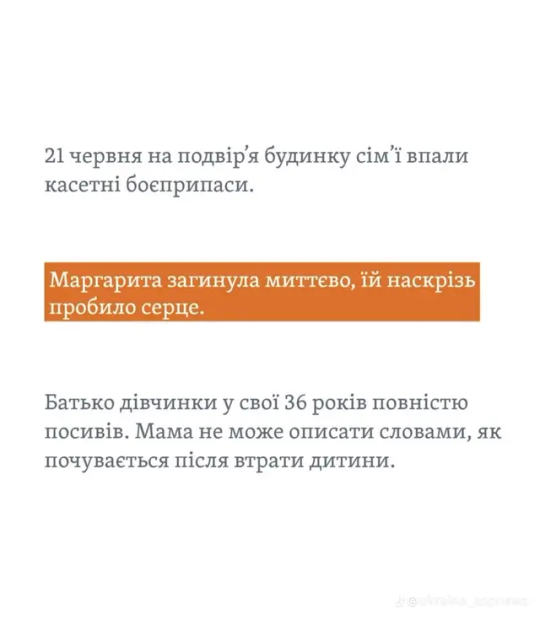
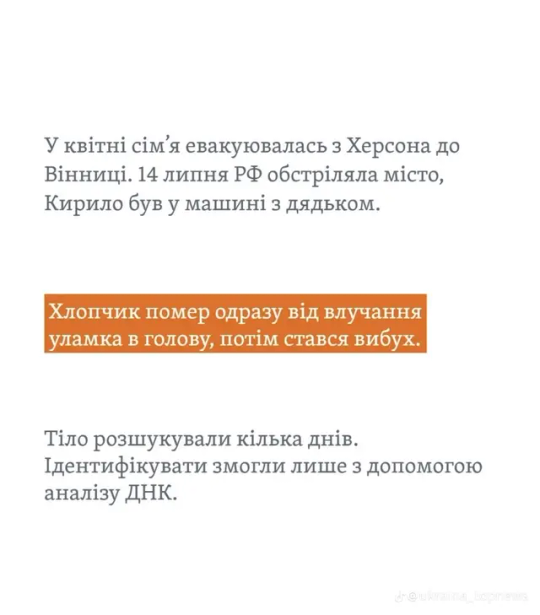
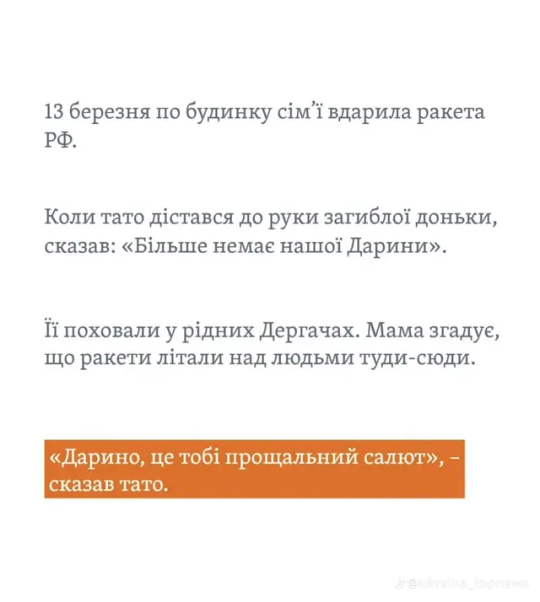
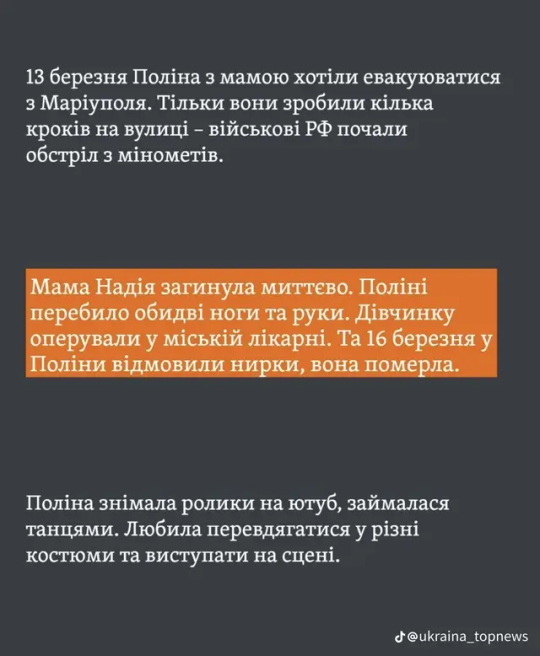
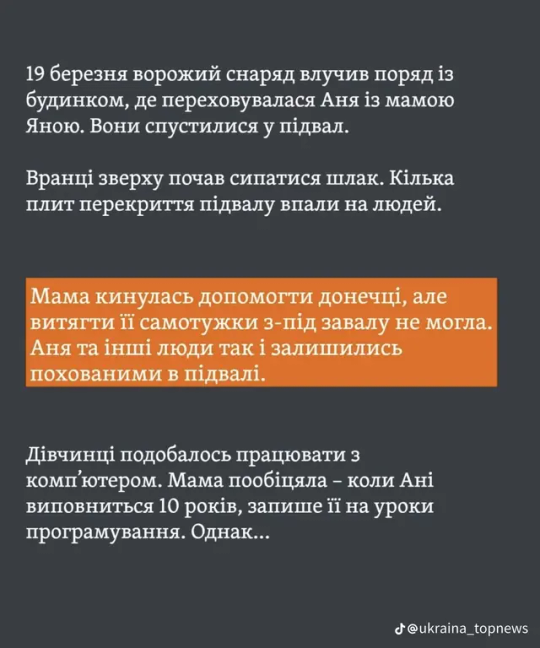
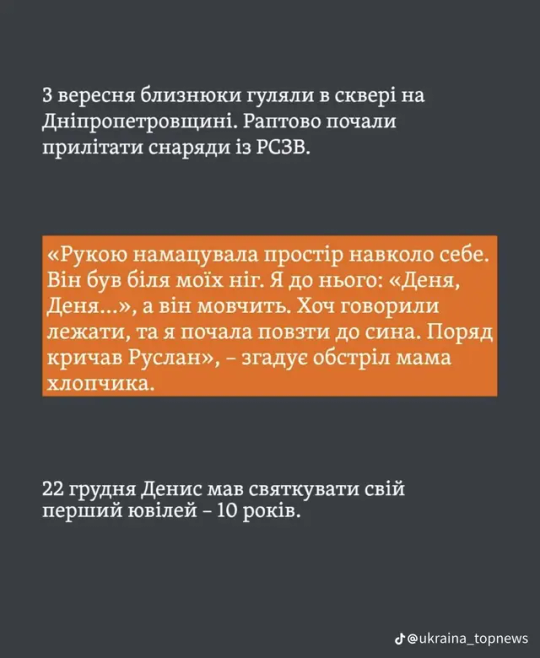
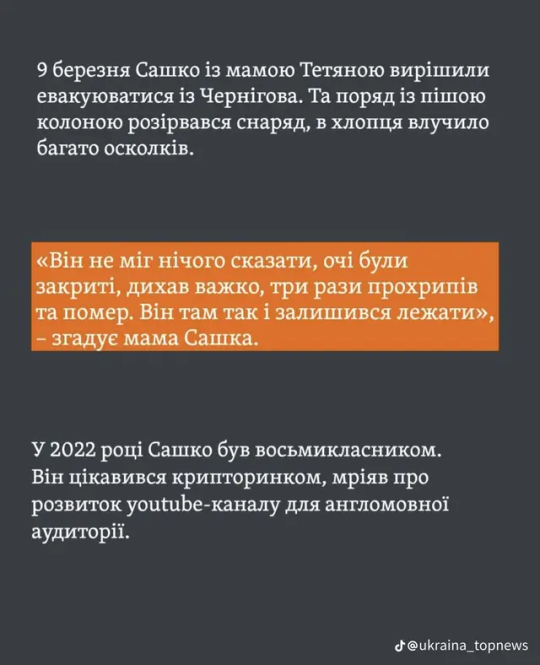
original post : ukraina_topnews
#ukraine#russia is a terrorist state#stand with ukraine#russiainvadedukraine#help ukraine#ukraine war#genocide#ukranian#children#war crimes#war#real story#kyiv#kherson#chernihiv#kharkiv
291 notes
·
View notes
Note
Ok but like the eggs--
I need to know if they grow!!!
Since there's so many are we under the assumption that reader will have hundreds of little babies? Maybe they fight in the womb (like some shark pups do)
I really hope reader has more than 1 baby since they're multiple little eggs and not just 1
OMG I'm so flattered you ask. I have a lot of headcannons and stuff for it, too! I will preface by saying this is OG headcannons and science, so I'm not abiding by any comics or real-life spider logic, haha.
Warning: sex talk/oviposition/pregnancy talk under the cut. My Miguel has eggs he dumps in you, be aware before clicking read more.
× ×
Okay, so, for Miguel, the eggs are stored in an additional pouch in his abdomen that connects via its own tube to his urethra. The eggs themselves are small, no bigger than a tapioca pearl, and cause no discomfort passing for him. That being said, he generates over one thousand in the span of 4 months. When that pouch gets overfull, it bloats and causes pain and discomfort for him.
When he passes them into reader, his precum/cum itself has a light numbing affect, which causes the cervix opening to relax. The eggs pour out right towards the end of his release, and they naturally gravitate into the cervix.
Once inside, they stick themselves around the womb in tiny clusters. Now comes the fertilization process, as they begin to draw nutrients from the cervical lining. Unfortunately, due to how many it is a battle of the best, and (good guess by the way!), they end up cannibalizing one another until only a few remain. The number of surviving eggs is dependent on the carrier's body health and the father's egg health.
So most likely, 500 eggs are released, 450 make it inside the womb, and they dwindle off one by one (or they fail to latch) and are dissolved by the mothers body. Most likely, due to the amount of space and nutrients needed, only 3 to 5 can survive and fit inside the womb.
After that process, they are generally the size of a golfball and will continue to grow. The casing of the egg breaks once the child is about three months (the babies absorb the egg casing!), and from there, they develop like normal human children.
That being said, the mother would most likely experience terrible side affects as the foreign DNA feeds on her body - the babies, before breaching their eggs, are basically extreme parasites - and it is difficult for mom to go through. But that'd be a whole other post for me to do haha.
Birthing is the same as a human, though with super babies, there will most likely be complications and dangers. Otherwise, yeah! That's how I think it goes. I also agree that the likelihood of having "just one" is small, and you'd definitely have a couple... which Miguel would love. He's always wanted a big family.
#miguel o'hara headcanons#miguel o'hara x you#miguel o'hara smut#miguel o'hara x reader#miguel o'hara#miguel spiderman#atsv miguel#across the spiderverse#spiderman 2099#spiderman across the spiderverse#spiderman x reader#spiderman atsv#spider man x reader#spider man: across the spider verse
894 notes
·
View notes
Text

the godzilla hybrids of Deicide (deicide biollantes backstory is close to the original because i really like it ) the difference is mainly that she retains some memories of the human side of her. however the others are a bit different
Space godzilla was created when ghidorah returned to space after a fight with godzilla. Carrying godzilla's blood on him as he left for deep space due to ghidorahs injures some of his blood mixed with godzillas causing it to crystalize. An alien race managed retrieved some of now crystalized blood and used it to create there own monster however that ended up destroying them as the kaiju drained them dry of resources. The young kaiju not fully developed left to continue it's gestation within a nebula cluster leeching of forming stars and eventually gaining massive amounts of energy and quickly maturing.
Zilla 001 was created as a military project an attempt to make a tame kaiju, using an Iguana Genome as a base they spliced it with that of godzillas dna. The sequence was also edited with the Dna of a dog in hopes of a more docile nature, the creature was given the name Zilla 001. (hes based Zilla Jr)
101 notes
·
View notes
Text
Poll 30, Round 1.

About Maria: (by @6larosie9) Maria was a lab baby made by Eggman as a way to collect and protect the chaos emeralds. He used Sonic and Shadow's DNA so she would be extremely strong and fast, and a very difficult challenge to anyone who tries to get in her way. Maria, Sonic, and Shadow are unaware they're related for the time being. She's a very determined hedgehog, competitive and cocky, and quite loyal to anyone she deems friends or family. Also, she secretly adores the outdoors and nature, but she'd never tell Eggman that.
About Mimi: (by @zeawesomeness) Mimi was born from a cluster of Black Arm eggs, sadly most of these eggs died, and due to Mimi having mostly alien DNA led to her being born in very poor health. She wasn't supposed to live past being a baby, which led to Shadow naming her Maria, but against all odds, she lived. She's very frail and can't handle physical exertion without dire consequences, making her very isolated, but the final blow to any possibility of a social life or even having friends for her is being a "freak with a third eye and tail." She has horrible anxiety due to being ostracized and things only seem to get worse when the ghost of her supposedly evil grandpa, "Black Doom", comes to haunt her into being evil. Only issue is he can't get her to stop crying long enough to listen to his evil monologue...
#sonic fankid showdown#sonic fanchild#sonic fankid#sonic oc#sonic the hedgehog#sth#sonic art#sonic fan character#sonic fandom#sonic fankids#sonic fancharacter#sonic fanchildren#sonic original character#maria the hedgehog#mimi the hedgehog#6larosie9#zeawesomeness#sfs 2#round 1; sfs 2#round 1 polls
105 notes
·
View notes
Text
Alright.... guys
It's time
SEBASTIAN DESIGN AND LORE DUMP !!!!
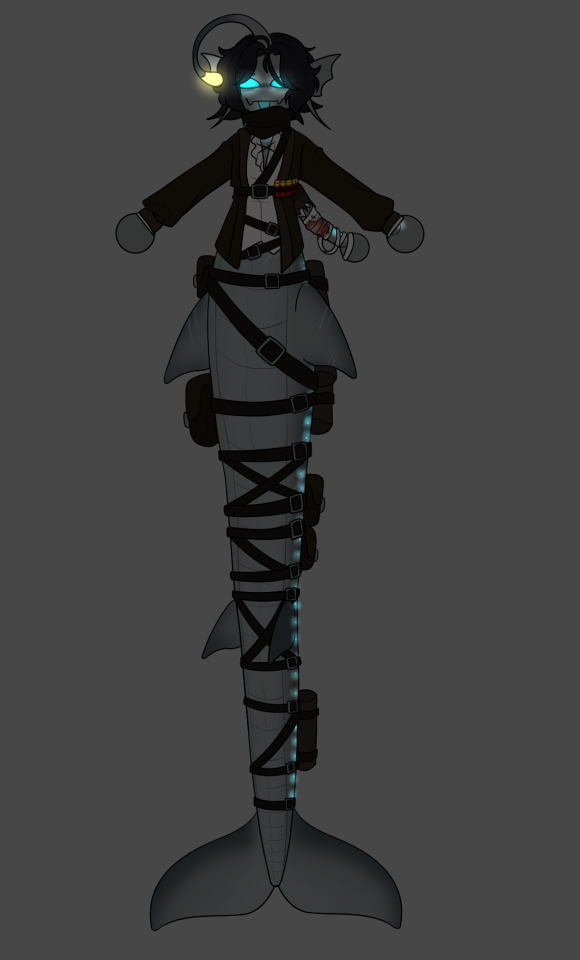
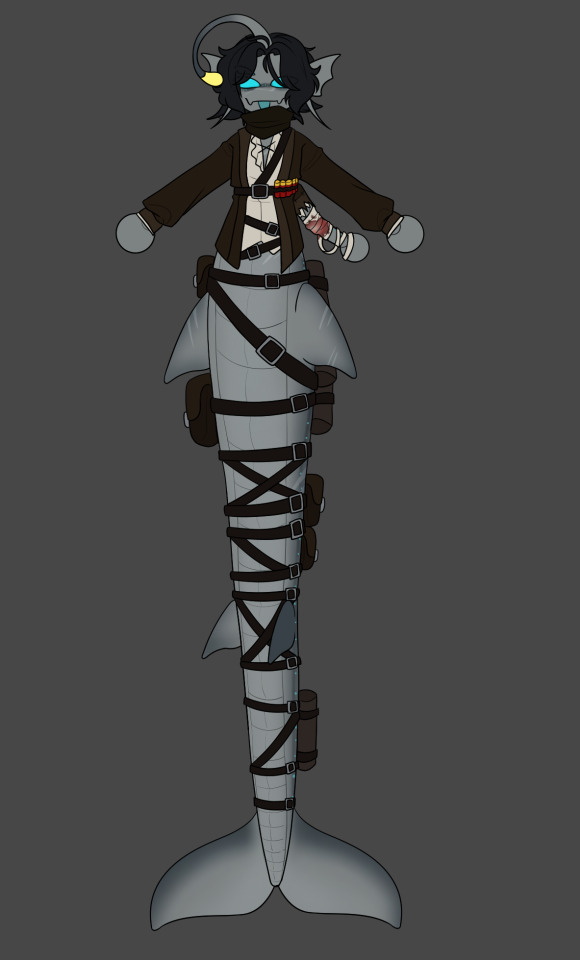
Both a glowing and normal version
Now, lore dump will be under the cut!
Here is the base of Sebastian, nakey ;p
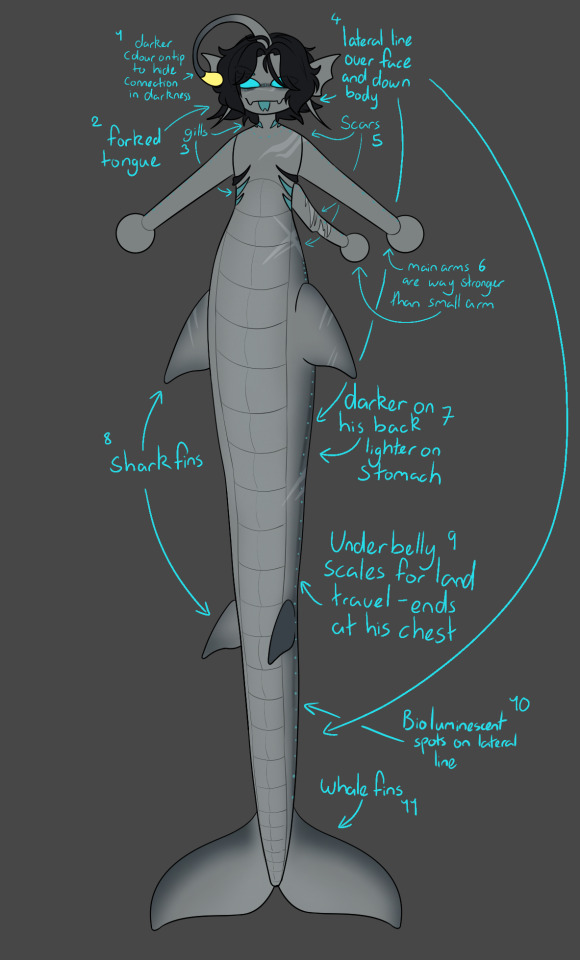
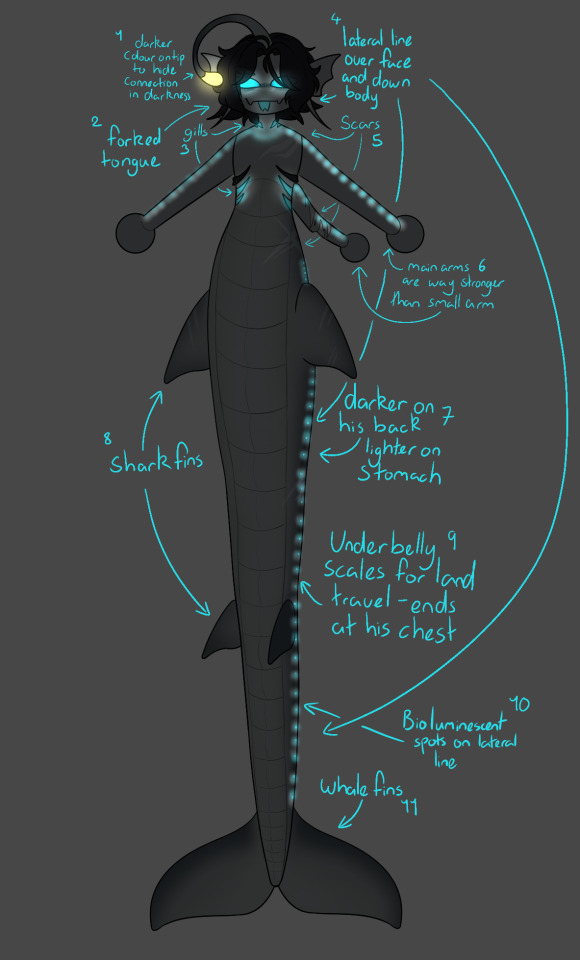
Now, those notes don't help much so heres the dump !!!!!!
1 Angler lure
his lure is a bit basic, no obvious species of angler is shown but more towards the end the colouration gets darker - something used to help camoflage the light when in the dark, made of a very soft cartilage which makes it very flexible
2 tongue
due to a bit of malformation on his face from the testing, he was given a forked tongue to help give him a better sense of smell esp while under water
3 Gills
there are two sets of gills on sebi on his neck and on his sides
3.1 neck gills
the gills on his neck aren't actually taking in any water, theyre used to filter the water and from the oxygen that he takes in from his mouth so water dosent get into his lungs
3.2 sidegills
his side gills do a LOT of the heavy lifting while hes under water, his top set of gills (black) Filters in water, keeping any particulates and other nasty junk out of his gills. While his bottom sets (blue) filter out water after the oxygen has been taken out
3.3
his lungs are still mostly human in nature, though now frills and other elements have been added to give aid to filtering water and oxygen, but also to protect what of his human lungs are left from getting filled with water and other fluids
4 lateral line
The lateral line on Sebastian spans his entire body, starting at his nose, going under his eyes, and down both sides of his body right down to the tip of his tail. Due to how deep the hadal blacksite is, being able to easily detect pressure (ha) changes and movements of others around him in places where it's dark or unsafe to use his lure.
4.1 electroreceptors
Like many fish, and especially for sharks, Sebastian has clusters of electroreceptors along his lateral line, localised to his face specifically. This gives him the ability to sense electrical stimuli, which makes it so Sebastian can sense electrical changes in others around him, giving him a high advantage over most people and creatures.
5 Scars
Sebastian has quite a few scars over his body, mostly localised to his top half as that's where his important internal organs are
Most scars hes got came from each operation that turned him into the leviathan we know him as today but he does also have quite a few after breaking containment and freeing the other Z-class entities from their own containment, fights with MTF from UrbanShade and a few self inflicted scars. (The main one being the scar on his face, as the one he had while human had seemed to vanish, and too feel like himself even a little bit he put it back)
6 Arms/Strength
With the addition of a manits shrip into his DNA his overall strength was increased greatly, his arms becoming much stronger than before - yes, his punches would hurt like hell, with his size and strength you'd be lucky to be more than a puddle of blood after one of his blows.
6.1 third arm
His third arm, smaller than his main set is actually quite weak, while not useless it's more of a supportive limb than anything, not that he likes having it anyway.
7 colouration
Sebastian's new skin tone and colouration takes on the Sam traits that a lot of fish have, darker on hid back and lighter on his stomach. His skin, especially on his lower half, has become slightly rougher in texture, being more akin to shark skin than any scaled fish, only having scales in certain places on his body (see point 9).
8 Fins
Sebastian has quite a few different kinds of fins along his body
8.1 'pectoral' fins
Just under where his human pelvis would be has two shark fins, very similar to pectoral fins, and greatly aid him in his movement underwater and a little bit with keeping himself steady and upright while on land. These are pretty rigid and Don't flex much
8.2 ventral fins
Very similar use to the pectoral fins, though they're quite useless on land.
8.3 dorsal fin (not shown in image)
Sebastian does have a dorsal fin, though it's more fish like as it spans from his shoulders, down his spine and tail, this fin helping with gliding through the water, mostly I'm smaller movements and even keeping himself still while not actively swimming.
8.4 ear fins
The fins on his head that replaced his ears have pretty much the same purpose as normal ears, though they're more sensitive and help his hearing underwater, giving him the ability to hear frequencies that humans cannot hear underwater.
9 Scales
While Sebastian mostly has a rougher sharks skin, he does have some scales. The most noticeable being his underbelly scales, something from the sea snake DNA that helps him travel more easily on land! These scales are smoother than the rest of his body so Sebastian is able to pretty much slither around
10 bioluminescenes
As many deep sea animals have bioluminesence, so does Sebastian, while only localised in certain areas. He has several lines of biolumenesence, especially down his lateral line across his face and body, as well as having some spots along his arms and collar bones.
11 Size / Whale fin
Okay, final point !!
An obvious thing about Sebastian is his sheer size, being that he's quite large and VERY long
These two factors come from the whale and sea snake in his DNA, whis also leads to his tail fin, being flat and whale-like instead of something more akin to the amount of fish in him, which this fact means Sebastian has remained warm blooded and a mammal. Do with that information as you will.
#sebastian pressure#sebastian solace#pressure#pressure roblox#pressure game#this has taken me so long....#two hours alone to write the info#about...#three days od drawing#please don't let this flop#Mobile formatting funked the post#Fixed it
64 notes
·
View notes
Text
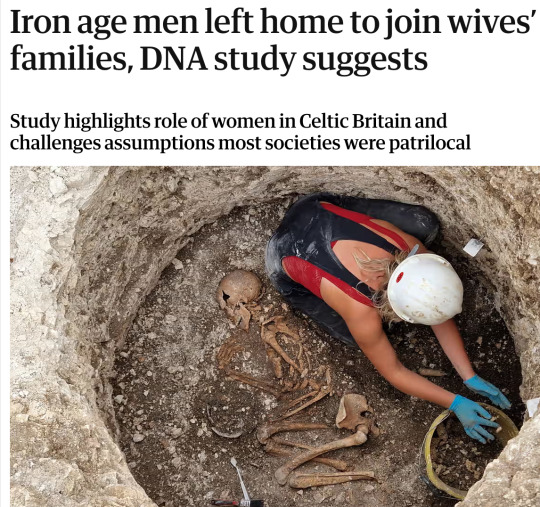
Iron age men left home to join wives' families, DNA study suggests (Nicola Davis, The Guardian, Jan 15 2025)
"Writing in the journal Nature, archaeologists report how they studied the genomes of more than 50 individuals buried in a cluster of cemeteries in Dorset.
Most of these individuals were associated with the Durotriges tribe, a Celtic group that occupied the central southern coast of Britain from about 100BC to AD100.
These sites have previously been of interest to experts, not only because iron age burials are rare but because the women tended to be buried with valuable items more often than the men.
“That is suggesting not much of a status difference between men and women, or even perhaps higher-status burials for women,” said Cassidy.
“How that actually then translates into the role of women in the society, that’s hard to say. And that’s why genetic data adds another important dimension there.”
Cassidy and colleagues analysed DNA and mitochondrial DNA – genetic material from within the cells’ powerhouses – revealing that the majority of individuals were related to each other.
Crucially, many shared the same mitochondrial DNA – genetic material that is passed down only from mothers to their offspring.
“They all were female-line descendants, [from the] same woman,” said Cassidy.
The team say this genetic evidence and modelling work suggest the community was matrilocal: in other words, the women stayed put, with men moving into the group to join their wives.
The conclusion was supported by considerable diversity in the Y chromosome of the men, with males showing significantly lower levels of genetic relatedness to other individuals, and by males being more likely to have different mitochondrial DNA than that which was widely shared.
The team then looked at DNA from other iron age burial sites across Britain, again finding signs of matrilocal communities.
“It’s looking that this is quite widespread across the island by that period,” said Cassidy.
While the study does not reveal whether the iron age societies had tribal groupings organised specifically around the maternal line, or suggest there was a matriarchy, the results offer new insights into the communities.
“Matrilocality is a strong predictor of female social and political empowerment,” Cassidy said, noting that if the women stayed put, they were more likely to inherit, control land, be players in the local economy, and have influence.
Writing in an accompanying article, Dr Guido Alberto Gnecchi Ruscone from the Max Planck Institute for Evolutionary Anthropology, said the findings echoed Roman writings that depicted Celtic women, such as Boudicca, as empowered figures.
“Although Roman writers often exoticised these societies,” he wrote, “the genetic evidence shown by Cassidy and colleagues validates some of their claims about the special role that women had in Celtic Britain.”"
37 notes
·
View notes
Text

Literally all of the Slugcats in my silly lil Rotten Hail AU!! Also, some lore on them and a version with a transparent background below the cut!

So, the lore!
Moon and Pebbles: Not shown here. During Moon's collapse, she fell westward, colliding with Pebbles' structure and knocking them both over. This created an eternal Blizzard inside their Facility Grounds. This event also caused the Rot to evolve via consuming the Neuronflies en masse, the Rot now assimilating creatures into itself instead of consuming them...
Survivor: Born into the colony fairly late into the Blizzard. Often does scavenging work, but has learned a fairly vast array of talents, meaning they can help out with pretty much anything, instead of specializing in specific subjects like most other slugcats.
Monk: Born into the colony fairly late into the Blizzard as well, specializing into animal handling and botany. Has diabetes, often carrying extra snacks in their bag in case her blood sugar drops out on the field.
Gourmand: The Colony's primary chef, as well as being a scout and part-time craftsman. Super kind and caring... though often forgets most do not have the appetite they do, often having guests passed out in their spare bed due to food comas.
Hunter: Created by NSH after Moon and Pebbles' collapse. Was very sick with Rot, but thankfully was brought back to NSH before it claimed them. Using samples of the evolved Rot, NSH created an injection that fused Hunter's rot into their body, causing it to stop eating away at Hunter and even granting them new abilities- at the cost of a drastically increased appetite.
Spearmaster: Created by Seven Red Suns as a messenger. After Moon and Pebbles' collapse, was given some specialized equipment. Due to their spaghetti DNA, their tail has grown in size quite excessively, and while this had made them less nimble, they now have the idea of spiking up their tail and swinging it like a giant mace, which has proven quite effective.
Artificer: Also created by Seven Red Suns for the purpose of destroying rubble and starting fires for warmth amongst the Blizzard. Her lost leg and missing eye are due to blood clots forming when she was young, and exploding violently. Was taught by SRS all the technological knowledge of how Iterators and Ancient technology work, and as such is a talented engineer.
Diver and Collector: Artificer and Hunter's pups. Green and Blue instead of red because of Arti's spaghetti DNA. Both carry Hunter's ability to middle alter their own bodies to extend their limbs a little bit, and also Arti's abilities, letting them to light up their bodies in bright, flashy bursts of fire, like little living Fireworks.
Rivulet: Created by a currently unknown Iterator before Moon's collapse, as a gift to keep her company. During the collapse though, got a concussion and memory loss, due to being inside Moon's structure. Lived on her own for a long time, scavenging for supplies under the freezing water. Now lives in the Colony, operating a water treatment machine below it.
Saint: Created by Sliver Of Straw as the Triple Affirmative. After meeting Gourmand, discovered their love of food. Still carries the power to Ascend others using their mechanical arm, but prefers not to unless asked to do it, or if it's the morally better option. Actually fairly chubby underneath their cloak now.
Nightcat: Slugcat from the Colony who, while on one of their first scouting missions, encountered a Rot Cluster who had learned to create immensely powerful bursts of light to flashbang foes. After the encounter, Nightcat was left permanently blind.
Inv/Enot: Cluster of Rot that was experimented on to create the Cure for Hunter. Became sentient and passive, taking on a vaguely slugcat-like form most of the time. Very silly and fun-loving, but also very anxious all the time, which they do their best to cover up. Often resides inside an abandoned Slugcat skeleton, using it to help their body maintain a stable form.
The Colony: The colony of Slugcats living on the outskirts of the Facility Grounds/Outer Expanse. With the guidance of Artificer, as well as SRS and NSH, the colony's home was revamped from a partially hollowed-out tree to a full-on town built vertically around it.
#rain world#rainworld#rw slugcat#slugcat#rain world slugcat#rain world artificer#rivulet rainworld#rain world au#rain world fanart#rain world art#rw survivor#rw monk#rw hunter#rw artificer#rw rivulet#rw gourmand#rw saint#rw nightcat#rw watcher#rw inv#rw enot#rw au#rain world downpour#RW Rotten Hail AU
28 notes
·
View notes
Text
New technique reveals how gene transcription is coordinated in cells
New Post has been published on https://thedigitalinsider.com/new-technique-reveals-how-gene-transcription-is-coordinated-in-cells/
New technique reveals how gene transcription is coordinated in cells


The human genome contains about 23,000 genes, but only a fraction of those genes are turned on inside a cell at any given time. The complex network of regulatory elements that controls gene expression includes regions of the genome called enhancers, which are often located far from the genes that they regulate.
This distance can make it difficult to map the complex interactions between genes and enhancers. To overcome that, MIT researchers have invented a new technique that allows them to observe the timing of gene and enhancer activation in a cell. When a gene is turned on around the same time as a particular enhancer, it strongly suggests the enhancer is controlling that gene.
Learning more about which enhancers control which genes, in different types of cells, could help researchers identify potential drug targets for genetic disorders. Genomic studies have identified mutations in many non-protein-coding regions that are linked to a variety of diseases. Could these be unknown enhancers?
“When people start using genetic technology to identify regions of chromosomes that have disease information, most of those sites don’t correspond to genes. We suspect they correspond to these enhancers, which can be quite distant from a promoter, so it’s very important to be able to identify these enhancers,” says Phillip Sharp, an MIT Institute Professor Emeritus and member of MIT’s Koch Institute for Integrative Cancer Research.
Sharp is the senior author of the new study, which appears today in Nature. MIT Research Assistant D.B. Jay Mahat is the lead author of the paper.
Hunting for eRNA
Less than 2 percent of the human genome consists of protein-coding genes. The rest of the genome includes many elements that control when and how those genes are expressed. Enhancers, which are thought to turn genes on by coming into physical contact with gene promoter regions through transiently forming a complex, were discovered about 45 years ago.
More recently, in 2010, researchers discovered that these enhancers are transcribed into RNA molecules, known as enhancer RNA or eRNA. Scientists suspect that this transcription occurs when the enhancers are actively interacting with their target genes. This raised the possibility that measuring eRNA transcription levels could help researchers determine when an enhancer is active, as well as which genes it’s targeting.
“That information is extraordinarily important in understanding how development occurs, and in understanding how cancers change their regulatory programs and activate processes that lead to de-differentiation and metastatic growth,” Mahat says.
However, this kind of mapping has proven difficult to perform because eRNA is produced in very small quantities and does not last long in the cell. Additionally, eRNA lacks a modification known as a poly-A tail, which is the “hook” that most techniques use to pull RNA out of a cell.
One way to capture eRNA is to add a nucleotide to cells that halts transcription when incorporated into RNA. These nucleotides also contain a tag called biotin that can be used to fish the RNA out of a cell. However, this current technique only works on large pools of cells and doesn’t give information about individual cells.
While brainstorming ideas for new ways to capture eRNA, Mahat and Sharp considered using click chemistry, a technique that can be used to join two molecules together if they are each tagged with “click handles” that can react together.
The researchers designed nucleotides labeled with one click handle, and once these nucleotides are incorporated into growing eRNA strands, the strands can be fished out with a tag containing the complementary handle. This allowed the researchers to capture eRNA and then purify, amplify, and sequence it. Some RNA is lost at each step, but Mahat estimates that they can successfully pull out about 10 percent of the eRNA from a given cell.
Using this technique, the researchers obtained a snapshot of the enhancers and genes that are being actively transcribed at a given time in a cell.
“You want to be able to determine, in every cell, the activation of transcription from regulatory elements and from their corresponding gene. And this has to be done in a single cell because that’s where you can detect synchrony or asynchrony between regulatory elements and genes,” Mahat says.
Timing of gene expression
Demonstrating their technique in mouse embryonic stem cells, the researchers found that they could calculate approximately when a particular region starts to be transcribed, based on the length of the RNA strand and the speed of the polymerase (the enzyme responsible for transcription) — that is, how far the polymerase transcribes per second. This allowed them to determine which genes and enhancers were being transcribed around the same time.
The researchers used this approach to determine the timing of the expression of cell cycle genes in more detail than has previously been possible. They were also able to confirm several sets of known gene-enhancer pairs and generated a list of about 50,000 possible enhancer-gene pairs that they can now try to verify.
Learning which enhancers control which genes would prove valuable in developing new treatments for diseases with a genetic basis. Last year, the U.S. Food and Drug Administration approved the first gene therapy treatment for sickle cell anemia, which works by interfering with an enhancer that results in activation of a fetal globin gene, reducing the production of sickled blood cells.
The MIT team is now applying this approach to other types of cells, with a focus on autoimmune diseases. Working with researchers at Boston Children’s Hospital, they are exploring immune cell mutations that have been linked to lupus, many of which are found in non-coding regions of the genome.
“It’s not clear which genes are affected by these mutations, so we are beginning to tease apart the genes these putative enhancers might be regulating, and in what cell types these enhancers are active,” Mahat says. “This is a tool for creating gene-to-enhancer maps, which are fundamental in understanding the biology, and also a foundation for understanding disease.”
The findings of this study also offer evidence for a theory that Sharp has recently developed, along with MIT professors Richard Young and Arup Chakraborty, that gene transcription is controlled by membraneless droplets known as condensates. These condensates are made of large clusters of enzymes and RNA, which Sharp suggests may include eRNA produced at enhancer sites.
“We picture that the communication between an enhancer and a promoter is a condensate-type, transient structure, and RNA is part of that. This is an important piece of work in building the understanding of how RNAs from enhancers could be active,” he says.
The research was funded by the National Cancer Institute, the National Institutes of Health, and the Emerald Foundation Postdoctoral Transition Award.
#000#Administration#anemia#approach#autoimmune diseases#Biology#blood#Building#Cancer#Capture#cell#cell types#Cells#change#chemistry#Children#chromosomes#clusters#coding#communication#development#Disease#Diseases#disorders#DNA#droplets#drug#enzyme#enzymes#fish
0 notes
Text
Some light ghoul world building!
Quintessence ghouls were highly found in darkened areas; caves, low-light forestries, or underground tunnels. This helped advance their magick and provided constant areas for any rituals or casts if needed. Because of this, however, their appearances are compared to corpses. Their colors stay cool; purples, greys, or even white. Their bodies don't produce melanin but if it does, it causes vitiligo! (Phantom :D). They're also notorious for having bad eye sight, and have "dead fish eyes", and can't handle being out in sunlight for long. Because of this, it was extremely rare to find a traveling healer or one willing to travel alone. Paws or hooves!
Air and Fire ghouls are more darker in color than other elements but still a wide variety, as they receive the most UV and heat, so their bodies produce more melanin. However, airs are more likely to be albino due to their climate and having the mutated gene. Fire ghouls have thinner hair than others, mimicking Devon rex cat breeds. Air ghouls are mainly covered in feathers rather than furs. While many believe fire ghouls to be the most aggressive, it's actually airs. They're more territorial, especially when it comes to mates. Air ghouls have talons, while Fire mimick canine or feline paws.
Water ghouls have the highest diversity as it all depends on their DNA and where they live. Freshwaters are more likely to be grey/brown/black/purple/darker tones. While Oceanics are more likely to be brighter, and borderline neon in some instances. However, their bioluminescence is the same hue. They don't have the ability to grow fur or body hair besides light peach fuzz. Some waters can have whiskers or more leviathan-descendants ghouls can have water moss. It's an ongoing joke that waters are the rabbits of the pits, but it's honestly true! Severely aggressive to other waters that aren't from the same territory, so requires slow introductions. They have webbed feet!
Earths are more neutral toned! Brown/deep browns/black/grey/tan/some deep green. This is mainly because of camouflage and needing to hide for hunts and survival. Some earths have the ability to cover themselves in patches of moss or even sprout tree limbs/leaves to hide in unconventional places. Their legs can easily be confused for bark depending if they have this ability or not bc of texture. Have the best eye sight and are known as silent killers as prey can't hear them until it's too late, it is also extremely rare for earths to attack other ghouls unless provoked. They weigh extremely heavy more than they appear. Very community based and more likely to take in orphans/strays of other elements. They have hooves!
Multi-Elements usually deprive from a single element, or have started a new line of evolution. Swiss falls under a quintessence line but is considered a "cluster" due to each element being more fragile. Aurora falls under a quintessence with a stronger water secondary, others as a "cluster." Sunshine is a direct air ghoul and a new line of evolution of Light, giving her the ability to manipulate light and sunbeams. Swiss and Aurora's features are very mixed and diverse (Swiss with talons but a quint tail, Rory with quint paws but air horns, etc), while Sunny seems to have slow evolving fire traits despite only being an air ghoulette (light fur over feathers and a sharper tail.)
#the band ghost#ghost band#rabrev writing#nameless ghoul headcanons#nameless ghouls#nameless ghoulettes#world building#ghoul world building
28 notes
·
View notes
Text
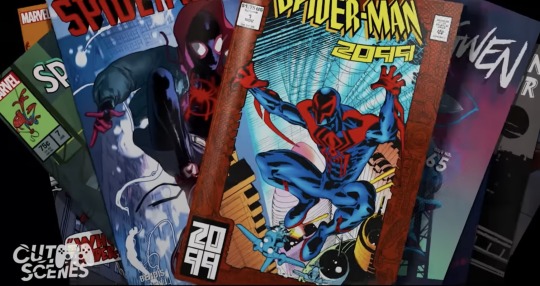
Okayyyy… let’s do this one last time. Or really, the first time for Miguel.
While ATSV doesn’t provide a summary of Miguel’s tenure as Spider-Man, the panels shown during the flip-through of his comic book are replicas of actual comic panels from his 90’s run and seem to cluster around specific issues and arcs. Here are some panels I was able to capture:
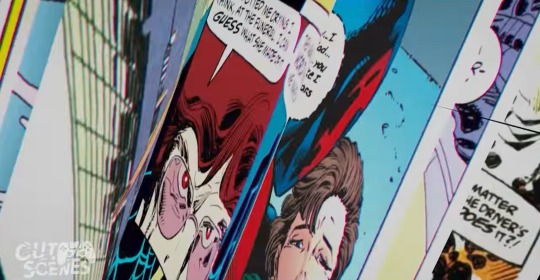
These panels are the first few shown during the flip-through. On the right, there’s a panel from Issue #1 that depicts Miguel’s origin story where Aaron Delgado tries to exact revenge, which accidentally gives Miguel his Spider powers. In the middle, there’s the panel from Issue #37 that depicts Dana D’Angelo dying as a result of the Venom 2099 arc, showing that Miguel has experienced his Gwen Stacy canon event. On the left, there’s a panel from Issue #10 that has Miguel gaining the resolve to become Spider-Man 2099.
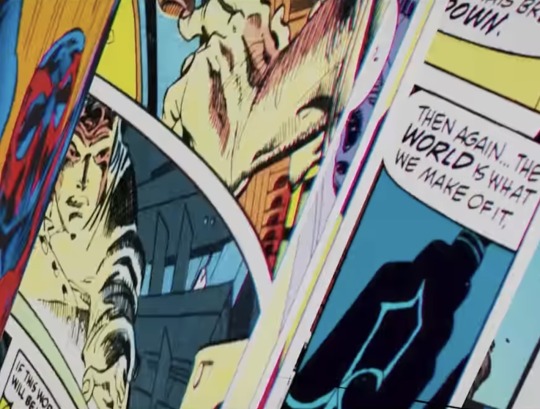
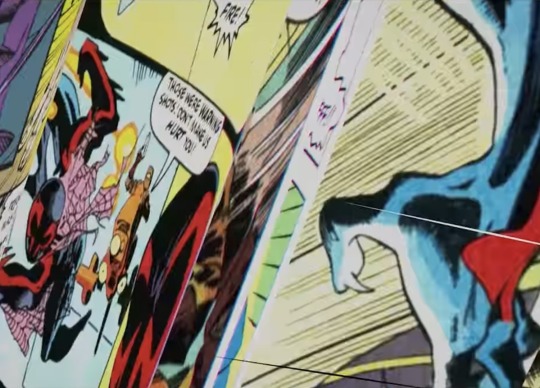
These panels mostly depict scenes from Issue #1. In image 1 (left), the center panel shows Aaron activating the machine that gives Miguel his Spider powers, demonstrating how Miguel is not like other Spider people because he got his mutation from an experiment, not a spider bite. Image 2 (right) depicts a panel located left, where Miguel is being chased by Alchemax officers.
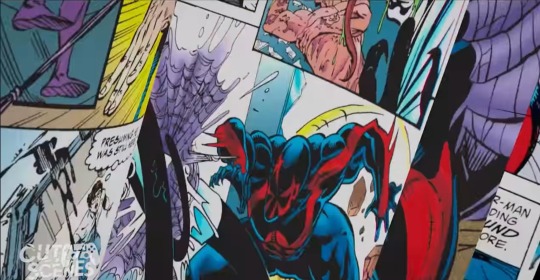
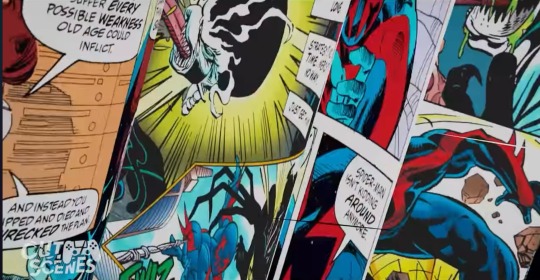
These images mostly show panels from Issue #36 where Miguel is fighting Venom 2099. Image 1 (left) shows Miguel using his organic web shooters instead of the film’s laser webs. Maybe this implies that Miguel still has his organic webs but opts for the laser ones instead. Image 2 (right) also shows a panel from Issue #10 on its left, where Miguel accepts being Spider-Man after confronting his deceased stepfather at a columbarium.
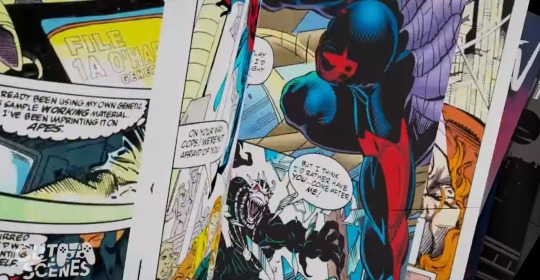
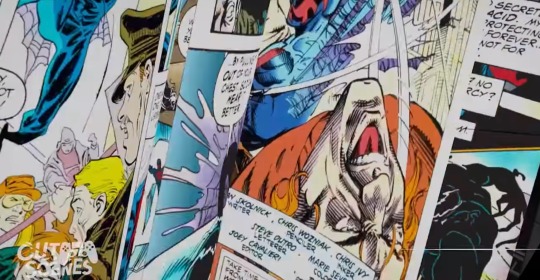
Image 1 (left) shows a panel from Issue #1 located on the left side and depicts the machine that programs Miguel’s DNA splicing. On the right side on Image 1, a panel from Issue #36 shows Venom 2099 having just evaded Miguel. For Image 2 (right), I can’t identify what comic issue belongs to this panel of Miguel punching a man wearing an orange outfit. However, this panel definitely from the 90’s run and is a title page. If anyone knows where this panel is from, please say so in the reblogs or the replies.

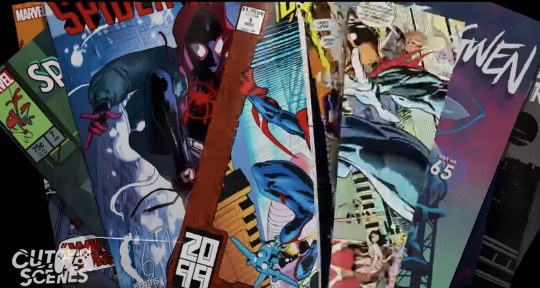
These last two images present this iconic large scale panel of Miguel that’s featured in Issue #1. Similar to the sequence presented in ATSV, it is the first panel the reader would see depicting Miguel when they open this comic.
Considering how much clustering occurs for Issues #1, 10, 36 & 37, it’s likely that these panels were intentionally chosen to foreshadow Miguel’s backstory. If Miguel’s backstory gets revealed in BTSV, the focus will probably be on his origin story, him gaining the resolve to become Spider-Man 2099, and his Venom 2099 arc to help explain the current state of his character.
#I was hoping someone crazier than me would make this type of post already#but here we are#guess it’s gonna be me#miguel o'hara#across the spiderverse#spiderman 2099#beyond the spiderverse#spiderverse
125 notes
·
View notes
Text
⋯ space themed id pack !!

names ⁘
andromeda ✴ orion ✴ aquila ✴ nebula ✴ lumen ✴ nova ✴ sirius ✴ gamma ✴ orbit ✴ stella ✴ celestia ✴ cosmo ✴ comet ✴ sol ✴ pleiades ✴ altair ✴ quark ✴ carina ✴ aurora ✴ aldebaran ✴ vega ✴ leo ✴ algol ✴ atlas ✴ mira ✴ pollux ✴ rigel ✴ auriga ✴ galaxy ✴ nyx ✴ singularity ✴ astro ✴ hubble ✴ jupiter ✴ zenith ✴ horizon ✴ ion

pronouns ⁘
star/stars ✴ gal/galaxy ✴ quark/quarks ✴ cos/cosmic ✴ shine/shines ✴ plan/planet ✴ ray/rays ✴ pul/pulse ✴ moon/moons ✴ lune/lunar ✴ neu/neutron ✴ par/parsec ✴ qua/quasar

titles ⁘
The Infinite ✴ (prn) Who Shines in the Night ✴ The Descendant of Stars ✴ The Celestial Knight ✴ The Remnant of Novae ✴ (prn) Who Bends the Light

system names ⁘
the expanse ✴ the nebula ✴ the oort cloud ✴ stellar catalogue ✴ starstuff system¹ ✴ the collapsing stars ✴ the globular cluster ✴ andromeda's children ✴ solar satellites
¹ from the Carl Sagan quote: "The nitrogen in our DNA, the calcium in our teeth, the iron in our blood, the carbon in our apple pies were made in the interiors of collapsing stars. We are made of starstuff."

Going through my old astronomy olympiad notes to make this... this was super fun and a big throwback to one of our special interests that's a bit more background these days. Enjoy! -Iris/Zoa
credits: 1
#cosmozoa— id pack#id pack#endo friendly#mogai friendly#name ideas#name suggestions#pronoun ideas#pronoun suggestions#system names#titles#title ideas#neopronouns#npt#npts#npt pack#space npt#mogai#cosmozoa— id pack 🌌
69 notes
·
View notes

